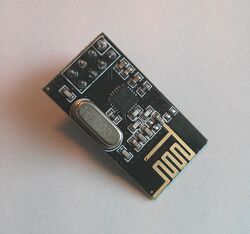Protocol decoder:nrf24l01
 | |
| Name | nRF24L01(+) |
|---|---|
| Description | 2.4GHz transceiver chip |
| Status | supported |
| License | GPLv2+ |
| Source code | decoders/nrf24l01 |
| Input | spi |
| Output | nrf24l01 |
| Probes | — |
| Optional probes | — |
The nrf24l01 protocol decoder supports the protocol spoken by the Nordic Semiconductor nRF24L01 and nRF24L01+ 2.4GHz transceiver chips.
Hardware
Modules with these chips can be purchased fairly inexpensive from various online marketplaces. Most (all?) use the following pinout:
| Pin | Function |
|---|---|
| 1 | GND |
| 2 | VCC |
| 3 | CE |
| 4 | CSN |
| 5 | SCK |
| 6 | MOSI |
| 7 | MISO |
| 8 | IRQ |
The chip has two chip select pins, "CE" used to control the standby mode, and "CSN" used for SPI communication.
Protocol
The chip uses the standard SPI protocol and pins (CSN, SCK, MOSI, MISO), with the additional CE (used to control the RX/TX and standby modes) and IRQ (used to inform the SPI master about the completion of a packet reception/transmission) signals. If the number of available pins of the master are scare, the CE pin can be tied to VCC and the IRQ ping can be left open, instead of it polling over SPI can be used.
SPI commands can have variable length, the CSN signal has to stay low during the whole command, and then go high after the last byte. The first byte of a command defines the type of the command, the chip always outputs its internal status register at the beginning. The following bytes are dependent on the command type, can be register values to write into the chip or payload data to send, or empty bytes that are ignored if the command only reads the output of the chip.